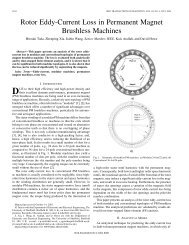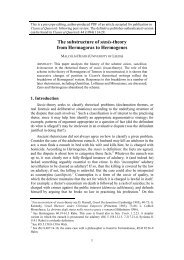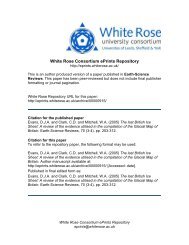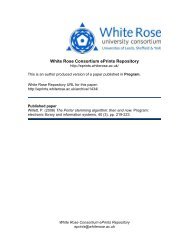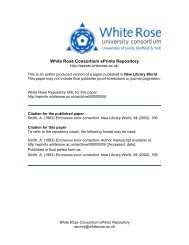The archaeological context of the Iwo Eleru cranium from Nigeria ...
The archaeological context of the Iwo Eleru cranium from Nigeria ...
The archaeological context of the Iwo Eleru cranium from Nigeria ...
Create successful ePaper yourself
Turn your PDF publications into a flip-book with our unique Google optimized e-Paper software.
and Daniels, 1984: 7). In <strong>the</strong>ir outline <strong>of</strong> <strong>the</strong> <strong>Iwo</strong> <strong>Eleru</strong><br />
succession, <strong>the</strong> excavators suggested that <strong>the</strong>re were two<br />
basic periods or phases into which <strong>the</strong> sequence could be<br />
divided, A and B, respectively aceramic and ceramic, each<br />
<strong>of</strong> which could be fur<strong>the</strong>r divided into two sub-periods.<br />
<strong>The</strong> four successive divisions could each be associated<br />
with certain <strong>of</strong> <strong>the</strong> “time vector plane” groups and <strong>the</strong><br />
radiocarbon dates, as follows.<br />
period sub-period TVP group radiocarbon date BP<br />
B B2 VI-VII-VIII 3465±65<br />
B1 V 5570±60 and 7030±85<br />
A A2 III-IV 9150±150<br />
A1 I-II 8685±120 and 11200±200<br />
Broadly speaking, it was suggested that <strong>the</strong> chronological<br />
boundaries for <strong>the</strong> periods and sub-periods were<br />
approximately as follows: A1 12,000-9000 BP; A2 9000-<br />
7000 BP; B1 7000-4500 BP; B2 4500-2000 BP.<br />
As stated, a basic criterion for <strong>the</strong> distinction between<br />
periods A and B is <strong>the</strong> appearance <strong>of</strong> pottery in B, certainly<br />
in B2 and probably in B1. Also characteristic <strong>of</strong> B is <strong>the</strong><br />
presence <strong>of</strong> ground stone axes and o<strong>the</strong>r ground stone<br />
artefacts, commonly made <strong>of</strong> very durable materials such<br />
as sillimanite, dolerite, and charnockite. Chalcedony and<br />
quartz was used for <strong>the</strong> chipped stone tool component,<br />
which alone characterised period A. One set <strong>of</strong> tools that<br />
appears in B2 are trapezoids, many with a pronounced<br />
gloss along <strong>the</strong> sharp edge, <strong>the</strong> position <strong>of</strong> which suggests<br />
slightly oblique hafting, possibly for <strong>the</strong> cutting <strong>of</strong> grasses<br />
or cereals such as sorghum (Shaw and Daniels, 1984,<br />
Fig. 38 a and b). Generally however it is noticeable that<br />
microliths (defined quite tightly as small tools with at least<br />
one edge trimmed by steep backing or blunting) decline<br />
in number <strong>from</strong> <strong>the</strong> base <strong>of</strong> <strong>the</strong> sequence upwards. <strong>The</strong>ir<br />
decline is balanced by an increase in <strong>the</strong> number <strong>of</strong> core<br />
tools and o<strong>the</strong>r heavy-duty pieces. This was tentatively<br />
interpreted in environmental terms.<br />
Environmental evidence<br />
Direct environmental evidence at <strong>the</strong> site is slight. Only a<br />
few small badly preserved fragments <strong>of</strong> animal bone were<br />
recovered and no information is available as to what species<br />
may have been represented (Shaw and Daniels, 1984: 30).<br />
Fish otoliths were identified in trench F 21 level 9. 12<br />
species <strong>of</strong> molluscs were recognised by Nora McMillan<br />
(in Shaw and Daniels, 1984: 142-144). Most frequent<br />
was Archachatina marginata, a land snail still commonly<br />
used for food at <strong>the</strong> present time. All <strong>the</strong> o<strong>the</strong>r land snails<br />
could have occurred naturally in <strong>the</strong> surroundings <strong>of</strong><br />
<strong>the</strong> site. Potadoma morchii is a freshwater species, and<br />
its appearance in trench S, where a red clay layer abuts<br />
<strong>the</strong> gneissic block at <strong>the</strong> back <strong>of</strong> <strong>the</strong> site, supports <strong>the</strong><br />
excavators’ conclusion that storm water did accumulate<br />
here <strong>from</strong> time to time. 4 cowries (Cypraea moneta)<br />
occurred near <strong>the</strong> surface. No macrobotanical remains nor<br />
traces <strong>of</strong> pollen were preserved.<br />
<strong>the</strong> ArchAeologicAl <strong>context</strong> <strong>of</strong> <strong>the</strong> iWo eleru crAnium <strong>from</strong> nigeriA<br />
33<br />
<strong>The</strong> environmental history <strong>of</strong> <strong>the</strong> site was <strong>the</strong>refore<br />
interpreted in terms <strong>of</strong> its geographical situation and in<br />
<strong>the</strong> light <strong>of</strong> what was <strong>the</strong>n known about <strong>the</strong> climatic and<br />
vegetational history <strong>of</strong> West Africa in general. Relying<br />
on <strong>the</strong> evidence <strong>from</strong> Lake Chad and Lake Bosumtwi,<br />
among o<strong>the</strong>r places, Shaw assumed that West Africa was<br />
generally dry in <strong>the</strong> late Pleistocene <strong>from</strong> about 18,000<br />
to 10,000 bc; <strong>the</strong> beginning <strong>of</strong> <strong>the</strong> Holocene <strong>from</strong> 10,000<br />
to about 5000 bc represented a climatic optimum; and<br />
<strong>the</strong>reafter <strong>the</strong>re were fluctuations, before <strong>the</strong> present<br />
climatic regime (involving desiccation <strong>of</strong> <strong>the</strong> Sahara) set<br />
in at about 2500 bc. On this assumption, <strong>the</strong> area around<br />
<strong>Iwo</strong> <strong>Eleru</strong> at <strong>the</strong> beginning <strong>of</strong> its occupation will have been<br />
generally dry savanna country. It was assumed that during<br />
<strong>the</strong> late Pleistocene <strong>the</strong> forest will have retreated to small<br />
relict areas along <strong>the</strong> coast, including <strong>the</strong> Niger delta. So<br />
<strong>the</strong> question was, when did <strong>the</strong> forest recover in <strong>the</strong> early<br />
Holocene, so that it embraced <strong>the</strong> <strong>Iwo</strong> <strong>Eleru</strong> area, and what<br />
happened after 5000 bc? Weighing all <strong>the</strong> odds, Shaw<br />
suggested that <strong>the</strong> forest may have advanced quite rapidly,<br />
moving northwards some 200 or 350 km in a few hundred<br />
years. He concluded that <strong>the</strong> forest will have covered<br />
<strong>Iwo</strong> <strong>Eleru</strong> by 5000 bc and that <strong>the</strong>reafter “it remained in<br />
forest until <strong>the</strong> end <strong>of</strong> <strong>the</strong> stone age occupation” (Shaw and<br />
Daniels, 1984: 52).<br />
Some elements <strong>of</strong> <strong>the</strong> <strong>archaeological</strong> succession were<br />
interpreted in that light. It was assumed that microliths<br />
equated with <strong>the</strong> use <strong>of</strong> a bow and arrow in open country,<br />
so <strong>the</strong>ir decline and replacement by heavy-duty equipment<br />
(as known <strong>from</strong> sites in o<strong>the</strong>r forested areas such as Blandè<br />
and Yengema: Shaw, 1978/79, Figs. 4 and 5) would be<br />
quite comprehensible. Shaw inclined to <strong>the</strong> view that <strong>the</strong><br />
advent <strong>of</strong> pottery was due to diffusion <strong>from</strong> <strong>the</strong> north, even<br />
perhaps with <strong>the</strong> “actual movements <strong>of</strong> people southwards”,<br />
since this was <strong>the</strong> time when desiccation commenced in<br />
<strong>the</strong> Sahara (Shaw, 1978/79: 60).<br />
<strong>The</strong> burial<br />
A human burial was found in square D 23, <strong>the</strong> various<br />
parts <strong>of</strong> which were at depths between 82 and 100 cm<br />
<strong>from</strong> <strong>the</strong> surface. A photograph <strong>of</strong> <strong>the</strong> skull as first located<br />
is at Figure 6, and a plan <strong>of</strong> <strong>the</strong> skeletal remains is at<br />
Figure 7. As already mentioned, <strong>the</strong>re is a radiocarbon<br />
date <strong>of</strong> 11,200±200 BP obtained on charcoal found in <strong>the</strong><br />
immediate vicinity <strong>of</strong> <strong>the</strong> burial. <strong>The</strong> skeletal remains<br />
were found in a space between and below two rocks, and a<br />
layer <strong>of</strong> calcareous concretions was observed in <strong>the</strong> same<br />
space, at a higher level, between <strong>the</strong> upper surfaces <strong>of</strong> <strong>the</strong><br />
two rocks. According to Shaw’s description, <strong>the</strong> corpse<br />
<strong>of</strong> this person “had been placed not far <strong>from</strong> bedrock<br />
… and covered with a shallow depth <strong>of</strong> soil early on in<br />
<strong>the</strong> shelter’s use” (Shaw and Daniels, 1984: 4-5). <strong>The</strong><br />
excavators believed that <strong>the</strong> body had probably been buried<br />
in a tightly contracted position. At <strong>the</strong> time, <strong>the</strong>y carefully<br />
considered <strong>the</strong> possibility that <strong>the</strong> burial may have been<br />
intrusive, and <strong>the</strong>y rejected this notion on <strong>the</strong> grounds<br />
that <strong>the</strong>re was no evidence <strong>of</strong> disturbance or <strong>of</strong> a burial<br />
pit. <strong>The</strong> “chalcedony index” did not indicate any anomaly




